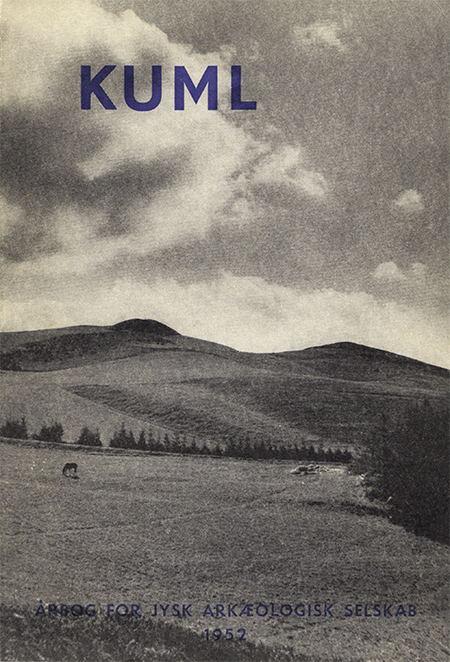Jellingebægeret - vor ældste kristne kalk?
DOI:
https://doi.org/10.7146/kuml.v2i2.24905Nøgleord:
Jelling, bæger, kalkResumé
The Jelling beaker - Scandinavia's oldest chalice?
By comparison with the unsubstantiated guesses concerning the occupants of the "royal barrows" of Upsala and of Borre on Oslofjord one would expect an identification of the Danish royal barrows at Jelling to be within the bounds of possibility. There are only two tumuli, and between them stand two runestones, naming two persons as deceased, King Gorm and Queen Thyre, both historical personages. The inscriptions show the smaller runestone to have been raised by Gorm for Thyre and the larger by Harald Bluetooth for Gorm and Thyre - "Harald who won all Denmark and Norway and made the Danes Christian".
The belief, already established by 1200, that the two tumuJi covered the bones of Gorm and Thyre respectively was unshaken until 1861, the discovery of a wooden grave chamber in the northern mound in 1820, plundered but still containing a few objects of great importance, not having given any grounds for doubt. But in 1861 the southern mound was found to be empty, a result which was confirmed by excavations in 1941 at the same time as it was shown that the southern mound is the later of the two, being built over the apex of an immense stone enclosure based on the northern tumulus.
The numerous theories which have been put forward since 1861 to account for the new situation have almost all assumed that Gorm and Thyre alone are buried at Jelling. The first exception was Sten Anjou's theory ("Fornvännen" 1934) that the southern mound was the cenotaph or cremation grave of both Gorm and Thyre, and that the northern mound, with its grave chamber, was the burial-place of Harald Bluetooth himself. This theory he based partly on the Christian character of three of the most important objects found in the chamber, a little pendant cross, part of a square bowl or tray which he interprets as a paten, and the famous Jelling beaker, which he believes to be a chalice.
The 1941 excavation has shown that Anjou's full theory cannot hold, as the northern tumulus is the older. The question of whether this tumulus is Harald's grave nevertheless remains and is of importance for Late Viking chronology.
There can be no doubt of the Christian character of the cross, whereas it is improbable that the tray fragment is part of the paten, a round chalice normally having a round paten.
The beaker (fig. 1) is of silver, 4.3 cms. high, decorated on the outside with splendid animal ornamentation. Its decoration is undoubtedly Scandinavian, whereas its shape is unique in Scandinavia within the Viking Period. It is the only drinking vessel with a stem and foot known and it is undoubtedly formed like a chalice, with base, nodus and cuppa. It is of a size which is not unusual for burial-chalices, normally travelling chalices, but its disc-like foot and conical angled cuppa do not resemble the known specimens of the period with high conical foot and rounded bowl (fig. 2). To the latter type belongs the hitherto oldest Scandinavian chalice, that from Skara cathedral in Sweden (fig. 3).
But while the Skara chalice is probably imported the Jelling beaker is of Scandinavian manufacture and may therefore well deviate from the European pattern. No other chalice of the first two centuries of Christendom in Scandinavia is known. However, two specimens, loosely dated to the Medieval Period, have been found in churchyards, the one at Tømmerup in Denmark (fig. 4) and the other at Aseral in Norway (fig. 5). If these two be set side by side with the Jelling beaker (fig. 6) the three give such an impression of a well-defined type that one might well ascribe what variations exist to differences in age.
But even though the Jelling beaker is therefore probably a Christian chalice does it therefore follow that the northern mound at Jelling is the burial place of King Harald? So far as we know grave-chalices were the prerogative of church dignitaries and it is unthinkable that the receptacle of Christ's blood would be part of the burial furnishings of a layman, even of a king. Such an irregular inclusion, against the customs of the church, smacks of a naive belief in the power of an object of Christian ritual to ensure the salvation of the person buried with it. But this magic would work equally well for anyone, Christian or heathen. Harald was baptised before he died and his salvation assured, whereas Gorm had died as a heathen and his soul, from a Christian standpoint, would be in extreme danger. It would therefore appear reasonable to give him a few objects in his grave which he could, if necessary, produce to St. Michael and St. Peter.
Gorm is therefore still the best suggestion for the occupant of the chamber in the northern mound. Thyre, on the other hand, may not be buried at Jelling at all. Two other runestones, at Læborg and at Bække, close to each other and halfway from Jelling to Ribe, were raised in memory of a Thyre who may well have been her.
C.G. Schultz
Downloads
Publiceret
Citation/Eksport
Nummer
Sektion
Licens
Fra og med årgang 2022 er artikler udgivet i Kuml med en licens fra Creative Commons (CC BY-NC-SA 4.0).
Alle tidligere årgange af tidsskriftet er ikke udgivet med en licens fra Creative Commons.


